Chapter 8: Teaching Science for Understanding: Focusing on Who, What, and Why
Sally G. Hoskins
THE CHALLENGE
As scientific decision-making is increasingly influenced by the non-scientist voting public, it is essential that all college students be well informed about science. Many are required to study the topic for at least one semester; however the student audience for general education science courses is often the same cohort that lost interest in science well before starting college. Such students may now get much of their science information from television, which alternates between frightening the audience with doomsday scenarios (“Hazards in your breakfast cereal! . . . News at 11”) and making heroes out of geeky gurus who solve complex medical mysteries in sixty minutes of prime time. Some students seem unaware of the accomplishments or relevance of twentieth- and twenty-first-century biology research, while others are not science-neutral but actively anti-science. Given that their votes on science-related issues will do much to shape the progress of science and society in the twenty-first century, students who do not choose to major in the sciences nevertheless need to understand who does science, what scientists do, and why anyone would be drawn to a science career.
With these issues in mind, I have shifted my focus in teaching biology for non-science majors from a broad-based yet superficial coverage of many topics to a more focused approach aimed at imparting not just content but also insight into the “who, what, and why” of science. I use scientific literature—whether magazine articles for the general public, research reports in scientific journals, or articles from newspapers or news websites—as a means to reveal how scientists think. I have designed classroom approaches that introduce non-science majors to some of the intellectual activities common to working scientists, including analyzing data, designing experiments, devising models to explain results, and constructively criticizing each other’s proposals. My goal is to demystify what scientists do, provide some insight into why someone would choose a science career, and at the same time increase respect for the processes and accomplishments of science research among students who are unlikely to engage directly in such research themselves.
DEPTH VERSUS BREADTH—THE EVOLUTION OF A TEACHING STYLE
Initially, I taught using traditional textbook-based lectures, drawing from a “biology for the non-major” textbook that used creative graphics and science stories taken from the news as a springboard for explaining basic principles. Despite the topical book, I found myself spending much class time going over pathways and processes that I knew the students had encountered in high school biology, memorized, and quickly forgotten. Rather than conveying an experience of “thinking like a scientist,” teaching in this way recapitulated the same approach that students had rejected previously. Many textbooks focus on scientific content in the near-absence of emphasis on scientific thinking, critical analysis, or creativity. They do not give students a real sense of how scientists design studies, interpret the data they gather, or use the findings to determine the next step in a long-term research project. Because the universal languages of study design and data analysis are at the heart of biology and are perhaps the aspects in which science differs most from nonscience fields, these topics deserve more focus, especially for the students least familiar with science.
Cognizant of the challenges of research science, the National Research Council has made specific recommendations on teaching science for understanding:
To develop confidence in an area of inquiry, students must
(a) have a deep foundation of factual knowledge
(b) understand facts and ideas in the context of a conceptual framework
(c) organize knowledge in ways that facilitate retrieval and application. (National
Research Council, 2003a)
Although these suggestions are aimed at “future research biologists,” I suggest that the latter two are also important for all science-literate citizens. In recent semesters I have altered my teaching approach for general-education science students, now focusing mainly on how scientists frame questions and test hypotheses. Because of the rate at which biology is changing, at least some of today’s “deep foundation of factual knowledge” may be tomorrow’s historical footnote. In the thirty years since I took introductory biology, entirely new fields (such as proteomics or bioinformatics) have developed, novel organelles (for example, the proteasome) and processes (like RNA interference) have been discovered in the cytoplasm, and recognition of an unanticipated conservation of developmental mechanism across phyla (see, for example, Lall & Patel, 2001) has spurred the emergence of a major field, evolutionary developmental biology. During the same decades, some long-held “facts” (such as the “fact” that no neurons are produced postnatally in the vertebrate nervous system) have been disproven by new findings. Thus, focusing on scientific facts at the expense of process shortchanges students and deprives them of insights into scientific approaches to problems.
For students whose single semester of college biology will be their last formal science course, perhaps what is needed is the development of a toolkit of approaches for use in understanding science as it grows and changes in the coming decades. Students need to be able to integrate new findings into their existing conceptual frameworks and, when necessary, construct novel frameworks. Ultimately, society may be better served if general education students have a foundation of scientific analysis skills, transferable approaches to scientific questions, and an understanding of the types of cognitive activities in which scientists engage on a daily basis, rather than “a deep foundation of facts” derived from what scientists have already done. I have shifted my classroom approach to focus on how to read/analyze science, how scientists approach problems, how to think critically about science, and how to develop, explain, and defend one’s own ideas about science.
ACTIVE LEARNING THROUGH SCIENTIFIC READING—BEHIND THE SCENES OF THE “VIRTUAL LABORATORY”
My current teaching uses active-learning assignments adapted from the C.R.E.A.T.E. method—consider, read, elucidate hypotheses, analyze data, and think of the next experiment (Hoskins & Stevens, 2009; Hoskins, Stevens & Nehm, 2007)—an approach that uses close analysis of primary literature (journal articles) to help upper-level biology students get “inside” research projects while simultaneously learning “who does science, and why.” The typical C.R.E.A.T.E. class studies a module of four papers published in series from one lab, thus following a research project as it unfolded in real time. The focus on data analysis in virtually every class session makes the C.R.E.A.T.E. classroom resemble a lab meeting, in which results are examined, interpretations are debated, and potential directions for follow-up experiments are considered. Students use novel pedagogical tools and carry out specific assignments at home in preparation for narrowly focused classroom analyses of a paper’s findings (see Table 1; Hoskins, Stevens & Nehm, 2007). Late in the semester, students complete email interviews with paper authors for behind-the-scenes insight into these scientists’ motivations and lifestyles.
Table 1: C.R.E.A.T.E. Steps and Activities Undertaken by Students in Class
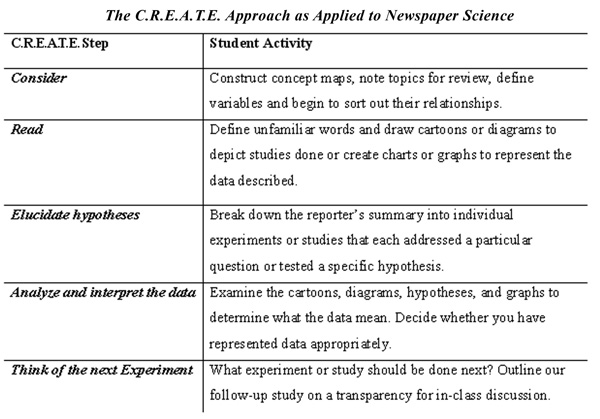
Source: Adapted from Hoskins, S. G. 2010. “But if it’s in the newspaper, doesn’t that mean it’s true?” Developing critical reading and analysis skills by analyzing newspaper science with C.R.E.A.T.E. American Biology Teacher 72(7):415–420.
As recommended in numerous science-education reform documents (AAAS, 1989, 1990; Brooks & Brooks, 1993; Glenn Commission, 2000; National Research Council, 1996, 2000, 2003a, 2003b, especially 20–21; Siebert & McIntosh, 2001), C.R.E.A.T.E. is an active-learning approach. It involves close analysis of a single line of scientific research, illustrating “the narrative nature of science” (Kitchen et al., 2003; Muench, 2000) and putting students into a “virtual laboratory,” where they interpret the papers’ findings and data as if they had made these discoveries themselves. This method aligns well with long-held views of educational psychologists regarding the mental activities that facilitate learning. In the mid-twentieth century, psychologist Benjamin Bloom determined that many exams tested primarily students’ ability to “recall,” “name,” or “classify,” yet many teachers would agree that real learning requires more complex cognitive activities, such as the ability to defend ideas, frame arguments, or design studies (Bloom et al., 1956). The Bloom scale is a six-point classification system for levels of mental involvement considered essential to learning (see Figure 1). Figure 1 can serve as a useful guideline for classroom activities that facilitate students’ ability to “think like scientists.” The C.R.E.A.T.E. method and the adapted outline in this paper aim to engage students in activities at the upper end of the scale—where research scientists spend a good deal of mental time—with the understanding that the ability to analyze, synthesize, and evaluate builds upon the foundation of facts and simpler concepts at the broad base of the pyramid.
Figure 1: The Bloom Scale
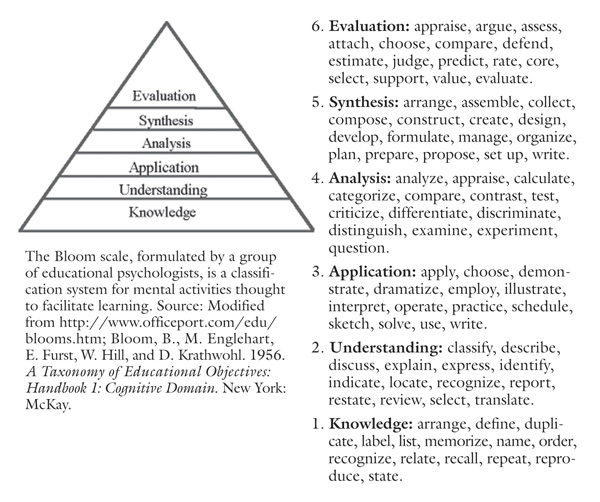
Although wet-lab work is not a part of the C.R.E.A.T.E. model, intense focus on the data of each paper through independent evaluation of every figure and table casts students as scientists working in a virtual laboratory. By concluding their analysis of each paper with a design for “the experiment I would do next,” students see that research does not follow a preset path; instead, multiple directions are possible. Vetting one another’s experiments in class builds students’ critical abilities while broadening their understanding of how science is funded. The author interviews humanize the research process by providing unique insights into the people behind the papers. For biology majors, this approach improves critical thinking and content integration skills and stimulates enthusiasm for science; it also enhances understanding of “who does research, and why” (Hoskins, Stevens & Nehm, 2007). Challenging general education students in similar ways should prepare these individuals to articulate their thoughts on science, explain the nature of science to their friends and families, and encourage understanding of and better attitudes toward science in the general public.
ACTIVE LEARNING FOR NON-SCIENCE MAJORS
I summarize below three active-learning approaches that I have developed for biology classes aimed at students who do not plan to major in science: (1) Science, Interpreted—a close reading of an article written for the general public with subsequent reference to the published article from which the lay account was derived; (2) Rewrite the Textbook—an illustration of how “established” science changes, through a classroom experience focused on a recent paradigm shift in developmental biology; and (3) It’s Published, But Should You Believe It?—an activity centered on newspaper/Internet science, perhaps the most likely source of post-college science information for the general education student. Each activity is designed for groups of twenty to twenty-five students and can be taught in elective classes or in laboratory sections of larger lecture classes. Alternatively, with enough small-group work and instructor energy, these approaches could be scaled to the large lecture hall.
My impression from the general education students I have taught is that many found high school science to be overwhelmingly detailed. Such students may approach college science with low expectations, assuming that memorization will be their main approach to the material. To jolt students out of a passive approach to biology, I introduce novel pedagogical tools such as concept mapping, cartooning, and figure annotation to help them actively engage with material they read in preparation for class (see Tables 1 and 2). Homework assignments call on students to (1) create concept maps (Allen & Tanner, 2003; Novak, 1990, 1998; Novak & Gowin, 1984) of introductory paragraphs to extract key ideas, ground themselves in the topic under analysis, and define areas for review; (2) draw visual representations (cartoons) of experiments described, thus creating a context that will aid their understanding of the reported results (Mathewson, 1999; Schnotz, Picard & Hron, 1993); (3) annotate all figures by relabeling them based on information in the narrative, methods (if present), and figure captions to ensure that they fully understand what is being represented; and (4) triangulate among figures, captions, and the paper narrative to define the broad question being addressed by the data in each figure or table. In sum, I challenge students to reconstruct the study; they review the methods, outline the experimental design, and interpret the data as if they had made the findings themselves. This level of at-home student preparation allows class time to be spent in discussion alternating with large- and small-group work in which the faculty member acts as a facilitator of active discussion rather than the sole source of information. Students spend the majority of class time engaged in higher-level cognitive activities thought to facilitate understanding (See Figure 1 and Tables 1 and 2; Bloom et al., 1956). This teaching style aligns well with twenty-first-century “active classroom” teaching practices (Bransford, Brown & Cocking, 2000; Knight & Wood, 2005) as well as with recommendations that the way science is taught should reflect the way science is actually done (Alberts, 2005; Handlesman et al., 2004; Steitz, 2003).
Table 2: Novel Classroom Activities Challenge Students to Think Deeply about Science
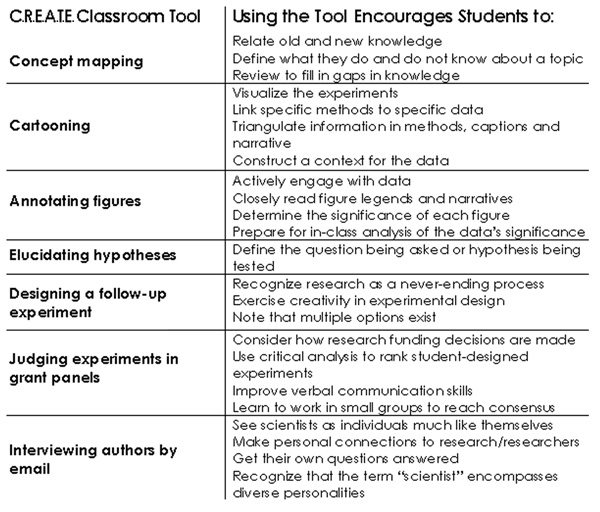
C.R.E.A.T.E. tools help address scientific issues often omitted from textbooks. Source: Hoskins, S. G., and L. S. Stevens. 2009. Learning our L.I.M.I.T.S.: Less is more in teaching science. Advances in Physiology Education 33:17–20.
Science, Interpreted
The general public gets much of its science not from primary sources but from digests of journal articles, that is, peer-reviewed work that has been summarized and condensed by a reporter and then edited for publication in a newspaper or general-interest periodical. To begin sharpening students’ critical reading skills, I assign one such article, “Babies Recognize Faces Better than Adults, Study Says,” published in National Geographic News (Mayell, 2005). This brief piece distills for the general reader a paper from Proceedings of the National Academy of Sciences (PNAS) titled “Plasticity of Face Processing in Infancy” (Pascalis et al., 2005).
After teaching concept mapping in an introductory class (Novak, 1990; Novak & Gowin, 1984), I provide students with the two-paragraph introduction to journalist Hillary Mayell’s article and ask them to map by defining key terms, creating diagrammatic linkages among them, and appropriately labeling the links. Students work in groups of three or four to quickly orient themselves in the topic area and sketch maps to review central issues. In this case, the article recaps a study that examined whether six-month-old babies could distinguish facial features of primates and recall them well enough three months later so as to know when a face not previously seen was added to the mix. Considering the research objective, students review what they know about the visual system, brain memory centers, and human development and raise questions—for example, how, in principle, could we measure whether a preverbal baby “recognizes” or “remembers” something?
We then read the rest of Mayell’s piece, and students return to groups to make visual representations, sketched on transparencies, of how the study was done. Mayell’s article does not provide any diagrams, so this “cartooning” step clarifies experimental methodology while raising questions that set the stage for later critical analysis of the method and findings. During this phase, students begin to realize they need more information about methods than is provided in the Mayell version. In response to specific questions, I supply additional information from the PNAS paper. We compare the groups’ cartoons and come to a consensus on how the experiment was performed: After an initial training session in which all participant babies viewed photos of monkey faces, the babies were split into experimental and control groups. “Experimental” babies were trained at home on similar photos over a period of months, control babies were not. All babies were subsequently tested at the lab, where they were videotaped while being presented photos of monkey faces, in pairs. Some pairs were composed of two faces that had been used previously, during initial (and for experimental babies, continued) training. Other pairings combined a photo that the babies had seen previously with a new monkey photo. Using a method developed in previous work, the experimenters measured “looking time,” or how long the infants gazed at particular pairs of photos, from the videotapes. “Longer looking time” for the pairings that included new monkey faces was considered evidence of recognition of novelty (Pascalis et al., 2005). Ultimately, if the experimental group looked longer at novel pairings than did the control group, the finding suggested that the former set of infants was better able to detect novelty. This in turn suggested that the trained babies remembered the faces on which they had trained, while the control babies were less able to recall the faces they had seen during only the initial session.
Students raise numerous questions about the study design and interpretation: Are the cognitive processes involved in “detecting novelty” the same ones involved in “recognizing” a familiar face? Do adults, when “recognizing faces,” stare longer at novel than familiar ones? What would “looking time” measurements be for a hypothetical additional control group, composed of babies that were never shown monkey faces? Is it okay that the control babies in the study experienced zero visual training during the months between the start of the experiment and the final testing, given that training for experimental babies involved periodically sitting on a parent’s lap and being shown a series of photos? As they delve more deeply into methodology, students begin to raise additional questions about aspects of the experimental design that are not included in the lay summary: how many babies were studied, what was the proportion of girls versus boys, and was the training standardized for the experimental group? Such concerns link to broad issues that must be considered in any experimental study.
Some students raise questions about possible differences in rate of cognitive development of girls and boys. As the more critical students explain their concerns (if girl babies talk earlier on average, might they also “recognize” earlier?), they gain experience at framing a scientific argument and backing up their opinions with additional facts (such as, do girl babies, on average, talk sooner, or is this hearsay?). Students research supporting evidence during class, providing an opportunity to address the validity of different sources of information available online. We turn again to the PNAS paper (Pascalis et al., 2005) for clarification on the demographics of experimental subjects. To practice representing data quantitatively, students convert the actual numbers of girls and boys in the study to percentages and draw a histogram. These data typically heighten student concerns. If girls are faster at developing the skills under study, students point out, then the fact that the experimental group was majority female and the control group was majority male is potentially problematic.
We consider what a reasonable sample size would be. Would an N of four be large enough? Do you need twenty thousand babies? Why or why not? We discuss the challenges of working with human subjects and whether an investigator can or should still carry out a study if conditions are less than “perfect.” This discussion can extend into a consideration of how statistical techniques can be used to aid in data analysis. The important issues raised in these discussions are not covered in depth in any of the “science for the non-scientist” textbooks I have investigated, but they are central to study design. As additional questions are raised, students who might have been intimidated if initially challenged to read a PNAS paper now look closely at the methods section for answers.
Many questions focus on the training/testing setup. All babies saw “training pictures” when they were six months old, after which the experimental group’s parents repeated the training task at home over a period of months, while control babies were not trained further. During both training and testing, babies were held on their mothers’ laps while viewing the pictures. Students point out that the control and experimental babies thus differed slightly in terms of experience with the mother, and suggest that less familiarity with the training/testing setup might have influenced the performance of controls during testing sessions. Other concerns include whether babies were all trained and/or tested at equivalent times of day (just before eating? just after a nap?) and whether any babies had “previous monkey experience” that could have been influential—that is, should the babies have been matched with regard to which ones had gone to the zoo, seen more primates in picture books, and so on? Even criticisms that seem far-fetched can stimulate useful discussion. Finally, some students raise the issue of a possible “Clever Hans” effect: if the mothers learned the discrimination task during the training sessions, which seems likely, might they have cued their babies during testing? The concerns raised link to general issues for experimental design: Has a potentially confounding variable been overlooked? Are additional controls needed? Can the method be improved? With a bare minimum of facts, students with little or no background in biology can critically analyze study design and begin to “think like scientists.”
Students are then challenged to design their own experiments centered on questions of facial recognition and/or visual memory in infants. Students initially work in groups of four to frame a hypothesis and create a group-consensus experiment, then sketch it on a transparency for evaluation by the entire class. (See Figure 2 for an example.) For homework, students design additional studies independently.
Figure 2: Modification of “Training” Phase of the Experiment, Designed in Class by a Group of Four Students Working on a Consensus Experimental Design
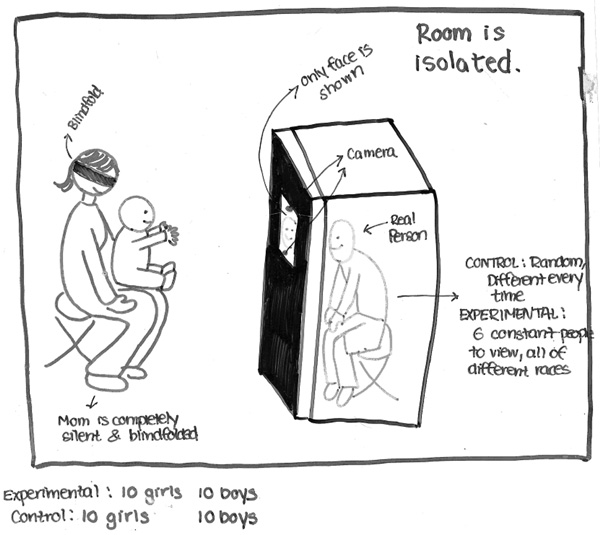
Here, the mother has been blindfolded to ensure that she does not learn the visual discrimination task.
Challenging students to diagram their experiment on a transparency, rather than just describe it verbally, helps them to commit to an idea and hone visualization skills. Providing a limited time frame in class for designing the experiments demystifies the process of experimental design and indicates that it is not an esoteric activity open only to “trained professionals.” Showing transparencies on an overhead projector facilitates in-class discussion. Teamwork on the early designs provides a nonthreatening forum in which shy students can express their ideas without fear of “sounding dumb” in front of the entire class, while the homework assignment stimulates independent thinking. Together, the range of ideas that emerge from the group and individual experimental design assignments underscore the wide variety of new studies that could, in principle, be performed. This approach helps alter preconceptions of science as a predetermined series of steps that lead to a known outcome (Ryder, Leach & Driver, 1999).
Student-designed experiments are vetted in a “grant panel exercise” (for details, see Hoskins, Stevens & Nehm, 2007), which is preceded by an activity aimed at illuminating the nature of science. Prior to evaluating proposed experiments, students are grouped into “grant panels” and charged with enumerating criteria that scientific panels “should” use in deciding how to allocate taxpayer dollars for science research. Each group lists bullet points for discussion. For almost all students, this experience is the first time they have considered how science research is funded, who makes funding decisions, or how competitive the process might be.
Typically, some groups suggest reserving funds for “established” scientists, leading other students to defend newcomers who might bring novel perspectives. Multiple groups propose that “the work must be relevant to human beings.” This statement provides a useful springboard for discussing model systems—that is, does the statement imply that for maximum “human relevance” all researchers should work on human beings? Barring that possibility, should everyone work on primates? Usually some students are cognizant of the fruit fly’s relevance to genetics, but few have thought closely about why studies using the fruit fly (Drosophila melanogaster), nematode (Caenorhabditis elegans), or the zebrafish (Danio rerio) might in fact prove “relevant to human beings.” In turn, considering why “model systems” are often funded provides an opportunity to review evolutionary concepts that students may have been exposed to previously but dismissed. The genetic code table, for example, was likely covered in high school biology but may not have been presented in an evolutionary context. Students begin to see that if human beings and simpler organisms all “spell” proteins using the same genetic alphabet, studying organisms with more accessible genetics could provide insights relevant to humans. Discussions of this sort are particularly interesting in classes with students who started the semester skeptical about the theory of evolution.
After the grant-panel criteria have been discussed, all student-designed experiments are viewed. The designs generally reflect a wide variety of approaches. (See Figures 3 through 5, for example.) Some students concentrate on making the control group more parallel to the experimental by, for example, instituting “control group sham training” in which control babies spend an equal amount of time in a training situation, but look at pictures of landscapes or nonprimate animals rather than monkey faces. Other students decide to use only girls or only boys in their study. Some alter the testing conditions so that the mother is blindfolded or the training and testing use pictures projected on the bedroom ceiling and viewed by the baby lying in a crib, thus eliminating possible parental cueing. Students see that experimental design requires careful thought and attention to controls but is not beyond the capacity of the average thinking person.
Student grant panels reconvene to discuss and debate the merits of the proposed experiments and select one for “funding.” This exercise links science research with broader societal concerns: what experiment has the greatest potential payoff, for instance, and can we necessarily tell in advance? The exercise also reveals some of the challenges professional scientists face on genuine grant panels: reaching consensus, the likelihood that the number of fundable experiments exceeds the funds available, and the fact that different panel members may have specific and strongly held agendas. The act of considering such issues helps humanize science and shows how personal and societal concerns intersect with basic research.
Figure 3: Sample Student-Designed Improved Experiment, Done as Homework
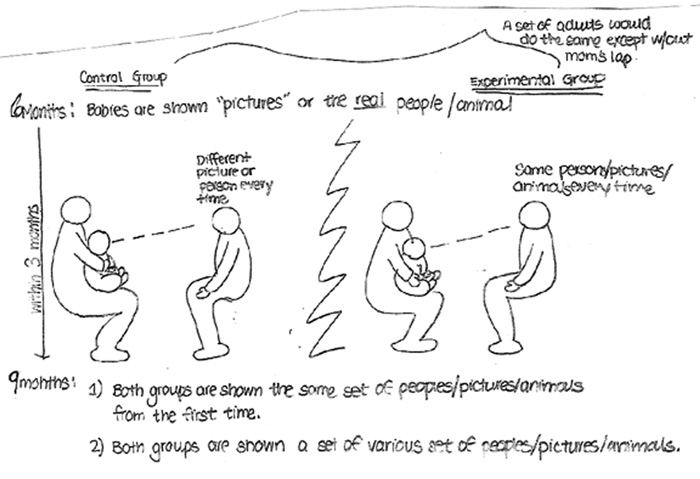
Figure 4: Sample Student-Designed Improved Experiment, Done as Homework
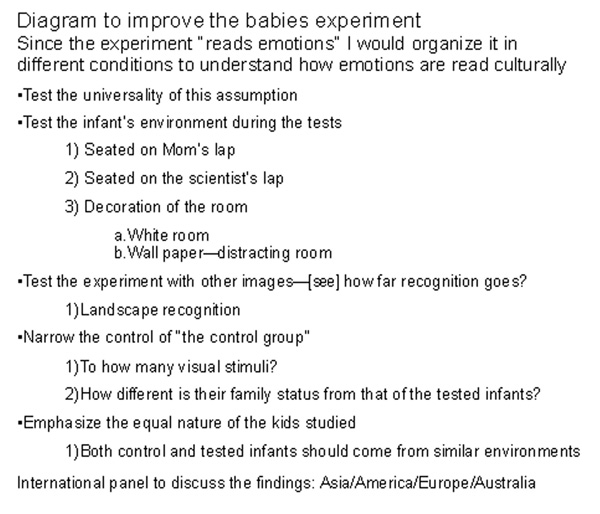
This student has considered multiple variables that could affect “recognition” and also has raised the issue of whether experimenters’ interpretation of babies’ emotional reactions to particular stimuli could be affected by differing cultural interpretations of emotion, based on country of origin. Whether all the variables raised could be addressed in a single study, or whether it would instead be wise to devise individual studies on particular sub-issues, can become a focus of further class discussion.
Figure 5: Sample Student-Designed Improved Experiment, Done as Homework
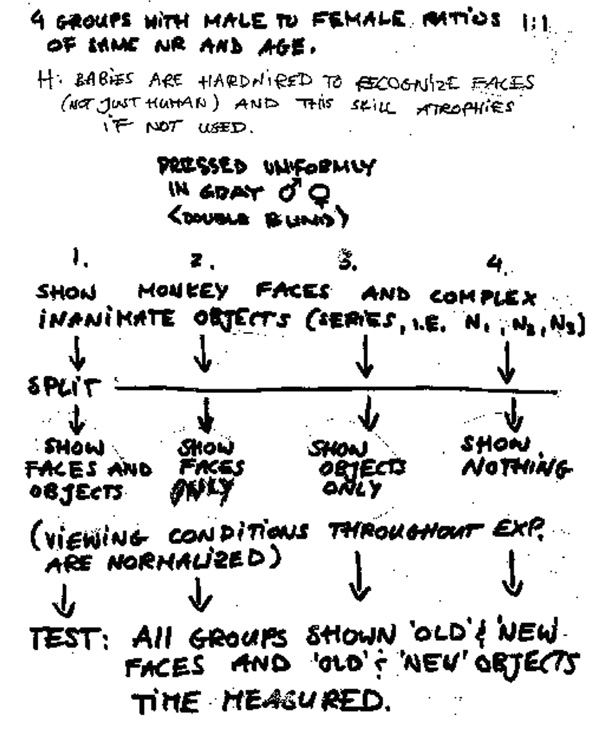
This student's improved experiment focuses on a question raised in class: whether "experimental" babies in the original study performed better during testing simply because they had been trained, not because they had been trained specifically on faces.
In a class with six grant panels five or more different experiments might be chosen as “the one to fund.” This outcome underscores the fact that neither scientists nor general education students playing the roles of scientists are a uniform population in which everyone thinks the same way. Overall, the grant panel exercise builds students’ skill at designing, defending, and debating experiments, while also humanizing scientists and providing insight into how science-funding decisions are made.
To conclude the babies/faces activity, I ask students for a one-sentence summary of the study. Many return to some version of the National Geographic News title, “Babies Recognize Faces Better than Adults, Study Says,” only to realize for the first time that no evidence in the article supports this claim. There is no direct comparison of babies’ and adults’ ability to recognize faces, nor a conclusion that babies are “better” at this task. The article’s main reference to adults is a casual claim regarding zookeepers and primates.
Students are startled to realize that even after closely reading the article, they accepted the title’s claim that “babies recognize faces better than adults” in the absence of supporting data. One student attributed this reaction to “the font effect,” writing: “We believe what we read. If the title is printed in a 72 point bold typeface crowning a two-column article it must be true, no questions about it; and more often than not, no further reading is necessary.” The PNAS title, “Plasticity of Face Processing in Infancy,” makes no claims about the recognition capabilities of babies versus that of adults. The class considers whether the magazine article was titled by the reporter or an editor and whether the desire for a catchy headline might have precluded accuracy. Students note that some key features of the PNAS study were absent from the version summarized for the general public even as a new “fact” about adults was added. This dialogue underscores for the non-scientist student both the need to read “digested” information about science with a critical eye, and the value of referring to primary sources when clarification is needed. Overall, active-learning tools and activities (see Table 2) applied to “simple” popularized science can help students learn to read critically, to visualize the experiments behind the summaries, to gain experimental design and evaluation skills, and to realize that in science writing for the general public something important may have been lost in translation.
Rewrite the Textbook: Paradigm Shifts and the Nature of Science
General education students often hold strong opinions about biological science that do not align with the reality of the field. Few seem cognizant of controversies in science, of sometimes nonlinear paths to discoveries, or of the evolutionary links among all forms of life. In addition to omitting consideration of the grant process, scientific textbooks tend to ignore the controversies, conflicting data, and failed hypotheses that are part of much scientific investigation and that, when analyzed, can stimulate understanding (Seethaler, 2005; Oulton & Grace, 2004; Mead & Scharmann, 1994). Non-scientist students who participate in the cognitive activities typical of science research labs—interpreting data, resolving controversies, creating models to represent and explain biological phenomena, and designing experiments—can gain appreciation for what scientists do, including the fact that sometimes scientists’ findings refute previously well-established “truths.” To help students discover that published textbook science may need periodic revision, and that even well-established scientific models may not hold up in the face of unexpected new data, I introduce a recent paradigm shift in developmental biology (for details, see Hoskins, 2008).
Paradigm shifts occur when well-established, widely accepted models are overturned by new data that cannot be made to fit (Kuhn, 1970). Most general education students have heard of the Copernican revolution, arguably the best-known example, but smaller-scale paradigm shifts can also be instructive. The history of developmental neurobiology includes a paradigm shift regarding early events in the formation of the vertebrate nervous system. With a brief introduction to the basics of embryogenesis—a minimal set of facts—general education students work through the logic of an experimental story as it progressed over seven decades, gaining insight into how scientific models develop and change.
Studying this issue also provides an opportunity for students to create explanatory models. While designing models based on experimental data is an important activity for scientists—the double helix probably the best-known example—modeling is not typically taught in the science classroom. As a consequence, students may be largely unaware of scientists’ use of visual representations to stimulate thinking and suggest new experiments.
I begin with embryonic development, reminding students that all the cells of their bodies can be traced back to the fertilized egg. First, focusing on the amphibian embryo, we review gamete formation, fertilization, and the cleavage divisions that rapidly produce in a three-layered embryo whose outermost layer, ectoderm, will eventually form both skin and nervous system. Second, I present key grafting studies carried out by embryologist Hilde Man-gold in the early twentieth century (Spemann & Mangold, 1924); the studies show that embryonic pattern formation involves cell-to-cell interactions and some form of signaling. Given Mangold’s results, student working groups are challenged to derive a consensus interpretation of the cellular interactions that give rise to the embryonic nervous system and illustrate those interactions with a diagrammatic model. Third, I describe additional studies of the system whose results are consistent with Mangold’s findings (Holtfreter, 1933; Nieuwkoop, 1969). Students integrate the new findings into their existing models and typically emerge with a diagrammatic explanation built on two postulates: 1) that embryonic cells are “preprogrammed” to form skin as “baseline fate”; and 2) that nervous system tissue forms when the preprogramming is overridden by an external chemical signal, such as that which hypothetically emanates from Mangold’s graft. (See Hoskins, 2008 for examples of models devised by student groups.) If prompted for a molecular mechanism, students propose that the graft caused the “turning on” of neuronal genes in nearby cells, overriding these cells’ inherent tendency to differentiate as skin. This interpretation parallels the historic idea that ectoderm could only produce neurons if induced by an external signal, a view that persisted in textbooks for more than a half-century.
At this point, I provide information from a later experiment (Hemmati-Brivanlou & Melton, 1992, 1994), with some surprising results—namely that ectodermal cells isolated from any “signal” differentiate as neurons, not skin. When asked to integrate the additional findings into their existing models, students soon discover that the modification is not possible, and frustration leads some to assume that at least one of the previous experiments is “wrong.” (In fact, the experiments and their outcomes have all been described accurately; the interpretation of the initial findings was inaccurate.) Without confirming or denying this possibility, I challenge students to design a new model that makes sense of all the results. Working in groups, students discover that this requirement can be met only if they are willing to abandon both of their initial postulates: that the baseline, preprogrammed fate of embryonic ectoderm cells is epidermal (skin), and that ectoderm cells become neurons only if they receive an external “instructive” chemical signal. Rather, according to students’ new models, the baseline, preprogrammed fate of embryonic ectoderm cells is neuronal. These cells become skin only if a signal they are already receiving from their neighboring cells, which is promoting their differentiation into skin, is turned off by the action of an external, overriding signal. To reach this conclusion, students must note that when cells communicate through chemical signals, the chemical communication might turn off an existing process, rather than simply activate a new process, as they had assumed initially. As pointed out by embryologists Ali Hemmati-Brivanlou and Douglas Melton (1997), this reinterpretation represented a fundamental paradigm shift in vertebrate embryology. As students grapple with conflicting data and the need to jettison their no-longer-useful original models, they experience many of the cognitive activities that characterize authentic science, where interpretations are not just matters of opinion but are data driven and where, if solid new data do not fit the prevailing model, the model, no matter how entrenched, must be reconsidered. The paradigm-shift story thus allows general education students to experience science both as a logical pursuit of explanations and an evolving set of interpretations.
An additional insight into the nature of science comes from Hemmati-Brivanlou and Melton’s observation that their paradigm-shifting data were not the first to conflict with the established model for neural/epidermal fate choice (Hemmati-Brivanlou & Melton, 1997). Nearly a decade earlier, two groups of researchers (Grunz & Tacke, 1989; Godsave & Slack, 1989) working on slightly different questions had also observed isolated ectodermal cells unexpectedly differentiating as neurons, even though the cells had not received any theoretically required “external signal” (see also Figure 6). Neither previous team, however, used its novel results as a basis for challenging the prevailing “skin is the default fate” model. Students closely read the discussion sections of each paper to determine how the unexpected results were explained, and note that each group found a way to interpret what had happened without drawing the conclusion that the new findings overturned a well-established model, suggesting that the influence of existing paradigms can be strong.
Figure 6: Using a Paradigm Shift to Illuminate the Self-Correcting Nature of Science
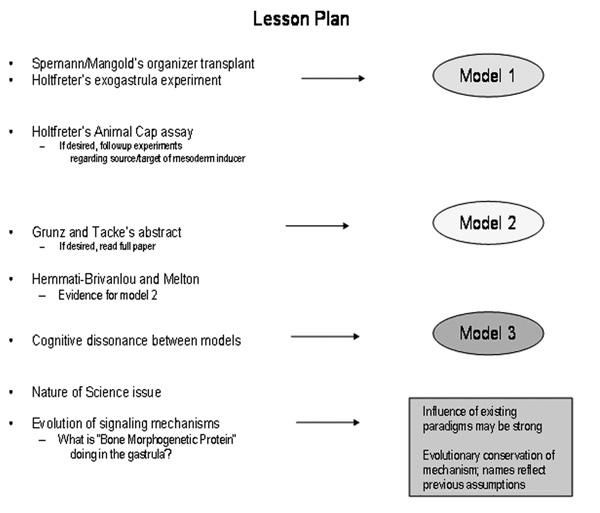
Depending on the instructor’s goals, some steps could be assigned as homework rather than being carried out in class. Source: Adapted from Hoskins, S. G. 2008. Using a paradigm shift to teach neurobiology and the nature of science: A C.R.E.A.T.E.-based approach. Journal of Undergraduate Neuroscience Education 6(2):A40–A52.
The paradigm-shift story also offers an opportunity to address student understanding of evolution, in this case in the context of “recycling” biological signaling mechanisms. Bone morphogenetic protein (BMP) (Kudoh et al., 2004; Zimmerman, De Jesus-Escobar & Harland, 1996) is a key player in the “decision” of embryonic cells to become skin or neuron, and is involved in active signaling among ectodermal cells at a stage when earlier researchers assumed no outside signals were being exchanged. When students consider that “bone protein” plays a role during normal development of the embryonic nervous system, they are initially mystified, often incorrectly proposing that mature bone cells are present in the embryo, or that the ectodermal cells that release BMP are bone precursors. Discussion of the history of BMP sheds light on the issue: the molecule was discovered in a bone cell growth assay and named at that time based on its presumed bone specificity. Unexpectedly, in a different scenario, studied by different researchers, the same factor plays a role. As one student pointed out, if this morphogen had first been discovered in the embryo, it might have been named “SIP—Skin Induction Protein,” in which case later investigators might have been surprised to discover a role for “skin inducer” SIP in developing bone. Students perceive that signaling molecules and mechanisms can be “recycled” in a variety of species and situations (Salie, Nierderofler & Arber, 2005) in unanticipated ways. Linking this discussion with the “model systems” issue outlined above illustrates why learning the molecular basis for pattern formation in such disparate organisms as fruit flies and frogs can be expected to provide results that will indeed be relevant to human beings.
Focusing on paradigm shifts helps dispel student preconceptions that science doesn’t change. A second example in the nervous system is the unexpected and dogma-contradicting discovery that the vertebrate brain is not “complete” at birth but in fact adds new cells postnatally. The finding that new neurons arise in adult canary brains (Goldman & Nottebohm, 1983) was followed by proof, in the face of some initial skepticism from the scientific community, that the new cells were genuine neurons (Paton & Nottebohm, 1984). The new cells were subsequently characterized anatomically, though the initial determination that nearly all were local interneurons (Paton, O’Loughlin & Nottebohm, 1985) was later supplanted by the finding that many are actually projection neurons (Alvarez-Buylla, Theelen & Nottebohm, 1988).
These papers form a useful module that, once the relevant techniques are clarified, is not beyond the grasp of general education students. The story is particularly interesting in that it includes both a major paradigm shift—the surprising discovery of newly formed neurons in adult vertebrates—and a follow-up study that missed a class of newborn projection neurons due to limitations in the then-available tracing techniques. The fact that all four publications are from the same lab is notable, and the story can be complemented by an interesting essay (Kaplan, 2001) from a researcher who was ahead of his time in the 1970s. He hypothesized that new neurons were born in postnatal mammalian brains, leading him to a career-threatening conflict with existing dogma. Examples such as these reflect the reality that new data may compel reevaluation of old interpretations.
It’s Published, But Should You Believe It?
Once general education students complete their college science requirement, many will not take another biology class. My overarching goal is to develop new habits of scientific thinking in such students before they return to a focus on history, architecture, philosophy, or literature. Ideally, attention to experimental design, the use of diagrams to aid understanding, the ability to construct models that organize data and suggest mechanisms, and the development of critical analysis skills will inform students’ approach to whatever scientific information they encounter in the future. A great deal of this information will likely come from the newspaper, online sources, or television (Gudrais, 2007; Knight Foundation, 2007). I thus developed a literature analysis activity focused on “newspaper science” (see Table 3; Hoskins, 2010).
Table 3: Newspaper Science as a Springboard for Discussion of Key Aspects of Science that are Underemphasized in Textbooks
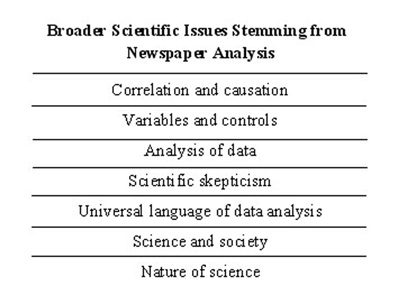
Source: Adapted from Hoskins, S. G. 2010. “But if it’s in the newspaper, doesn’t that mean it’s true?” Developing critical reading and analysis skills by analyzing newspaper science with C.R.E.A.T.E. American Biology Teacher 72(7):415–420.
Science articles found in newspapers and on the Internet often refer to data but do not include illustrations, making it easy for casual readers to ignore the actual findings that (theoretically) underlie the headlines. Reporters may give the briefest of overviews or only superficially summarize information from studies published in scholarly journals. Information lost in the editing process may make the scientific basis of the newspaper claim difficult to understand or even inaccurate. Newspaper science is thus an excellent venue for training students to read critically and skeptically, enhancing the skills that support development of scientific literacy (Elliott, 2006; Strauss, 2005).
One example of newspaper science that I have used in teaching general education students is an article titled “Study Links Produce Prices to Obesity” (Rundle, 2005). (For details, see Hoskins, 2010.) The article reports on a study funded by the Rand Corporation and published in the journal Public Health (Sturm & Datar, 2005). Per the newspaper version, the study examined children’s weight gain over a three-year span—kindergarten to third grade—in a range of cities in the United States. Prices of fruits and vegetables in those communities were also monitored. The article gives the casual reader the impression that when produce prices rise, parents buy less produce and, as a consequence, children eat less produce, consume fast food instead, and gain excess weight. No data are presented supporting any of these implied causal relationships, however. The article provides some information on produce prices and children’s average weight gain over the three-year span in two towns, one in California and one in Alabama. Part of the challenge for students reading this article is to determine whether the study described indeed “links” obesity to produce prices. As students work through this issue, they also consider the broader question of correlation and causation, a fundamental distinction often overlooked in science-based arguments made to the general public (see Table 3).
Students orient themselves in the subject area by concept-mapping the topics of food, weight, and produce prices and considering multiple variables that relate to each (see Figure 7). They next hone visualization skills by asking themselves how the study must have been done, that is, what sort(s) of data would compel the conclusion that there are “strong links” between produce prices and obesity, and how might such data be gathered? Students make their own decisions about what hypothetical data to represent and how to represent it. This is the first time many students have been challenged to represent data without being told how or being provided prelabeled axes. As charts from different groups are compared, common graphing errors can be addressed; for example, some students connect points that represent different cities with a (meaningless) continuous line because “it’s a graph; you always connect the dots” (See Figure 8; Clement, 1989; Berg & Philips, 1994; Foertsch, 2000).
Figure 7: Group Concept Maps Done Quickly in Class as a First Step in Analyzing the “Produce Prices” Article
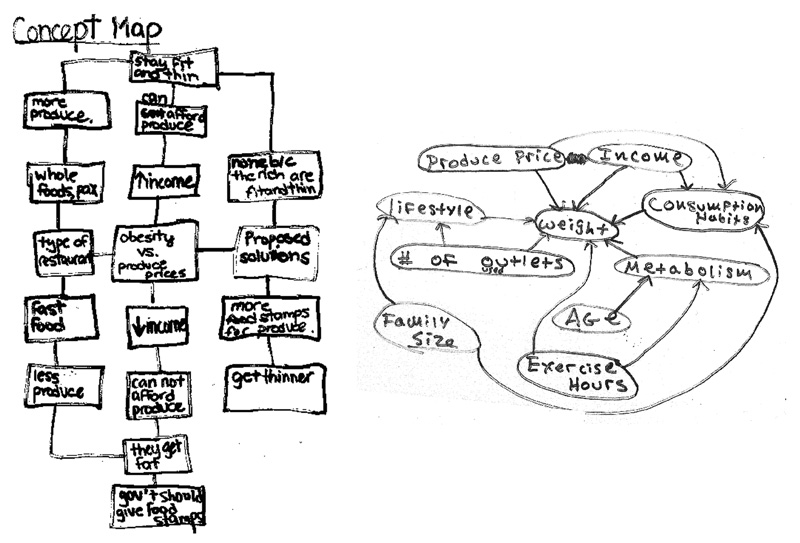
Links are unlabeled. Note that different groups emphasize different ideas, with one map (left) focusing on income as a central factor, and the other noting income as one factor along with metabolism, exercise, and consumption of produce. Comparing maps in class prepares students to discuss the scientific issues that underlie the article, while underscoring the fact that different individuals (and by extension, scientists) can view the “same” data differently.
Figure 8: Sample Data Produced by Students Working in a Small Group During Class
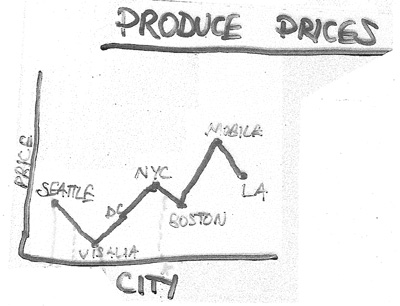
This figure reveals misconceptions about graphing that are addressed later with the entire class.
Students are initially unconcerned about the scope of the study, which encompassed around 6,900 children in 59 towns. Plotting graphs and thinking about how the study might have been done raises questions of sample size, and in turn, the question of whether studying some 117 children per community is a sufficiently large sample, especially in large cities with diverse neighborhoods. This concern bridges to a discussion of a fundamental issue: to what extent does one’s confidence in conclusions reached depend on the size of the population studied, whether that cohort is populated with children in a obesity study or by citizens polled on a political issue?
Students initially accept the article at face value, but after concept-mapping it, carefully examining the data, and thinking about how they would study the obesity question, they are startled to note in the final paragraph that “the Rand study didn’t measure actual consumption of fruits and vegetables anywhere in the country” (Rundle, 2005). Given that the title claims “links” between produce prices and obesity, the lack of data on what was eaten by the children whose weight was monitored raises concerns and provides many ideas for student-designed improved studies.
Challenged to design a study or experiment that checks for actual causal relationships, some students propose overseeing the diets of selected subsets of children, carefully matching control and experimental populations. Some design broad surveys to examine whether parents in fact buy less produce when it is expensive. Others plan experiments in animal model systems, in which the food intake weight of one cohort of laboratory mice eating fruits and vegetables and another eating the rodent equivalent of a fast-food diet can be closely monitored. Student grant panels evaluate proposed studies and discuss how their findings could potentially be applied to improve human health. In this context, a sidebar discussion of the U.S. Department of Agriculture’s changing food pyramid (that is, comparing the 1994 and 2005 versions) provides additional insight into the nature of science. In this case the focus is on the issue of whether nutritional recommendations from the U.S. government are made or revised based exclusively on nutritional research, or whether food lobbies also play a role.
Applying new analytical tools (Table 1) to newspaper science allows students to experience, after reading fewer than 750 words, critical analysis, data representation, interpretation of charted findings, design and vetting of studies, and consideration of how science research is funded. Ideally, students gain fluency in the language of scientific analysis and master skills that they can apply to any scientific reading, however casual, that they do in the future.
PERSPECTIVE AND PROSPECTS FOR CHANGE
Taken together, the active-learning approaches I have adapted for the general education classroom complement approaches typical of textbooks by providing opportunities for students to think independently as they design experiments or criticize methods (see Table 4). Students working with other student-scientists to reach consensus in group experimental design challenges or grant-panel debates may begin to view science as a social activity rather than one open only to antisocial geek-geniuses of popular culture’s stereotypes.
Table 4: Complementing Textbook Teaching with Literature-Based Approaches Provides Insight into Scientific Thinking and Science Process
| ISSUE | Textbooks Aimed at General Education Students | Science Articles Scaffolded to Original Papers | Focus on Paradigm Shifts | Close Analysis of Newspaper Science |
| Focus mainly on content | X | |||
| Focus mainly on scientific process | X | X | X | |
| Use creative graphics to clarify content | X | |||
| Create your own graphics to clarify content | X | X | X | |
| Read with a critical eye | X | X | X | |
| Learn that “established” science can change | X | X | ||
| Move from verbal description to data representation | X | X | X | |
| Learn to evaluate scientific proposals in grant panels | X | X | ||
| Find more than one way to answer a scientific question | X | X | X | |
| Learn to design a good experiment | X | X | ||
| View science as creative | X | X | X | |
| Learn to intelligently criticize research findings or proposed experiments | X | X | X | |
| Focus on the universal logic of data analysis | X | X | X |
C.R.E.A.T.E.-based activities complement the content coverage typical of textbooks in order to actively involve students in key aspects of scientific thinking.
To get a sense of whether student attitudes about science shift over the course of the semester in classes using such approaches, I probed opinions in an anonymous pre/post survey. Students responded to a series of statements about science, biology, and science/society issues by indicating the degree to which they agreed or disagreed with each proposition (for example, “Experiments in model organisms like the fruit fly have led to important advances in understanding human biology”). In two general education cohorts (2006, 2007), I administered the survey during the first and final classes of a fourteen-week semester, in a biology course focused on genetics, development, and evolution. Surveys were coded with numbers known only to the students themselves, to allow statistical comparisons between individuals as well as groups. In each cohort, students underwent significant shifts on measures of self-rated understanding of content (Figure 9a), understanding of applicability of research on model organisms (Figure 9b), self-rated ability to visualize experimental scenarios (Figure 9c), and self-assessed critical reading skills (Figure 9d). While these shifts must be interpreted with caution because of the small sample sizes, they suggest that active-learning approaches can help students gain deeper insight into science.
Figures 9a–9d: Contributions of C.R.E.A.T.E. Methods to Student Gains in Insight into the Nature of Science
Figure 9a
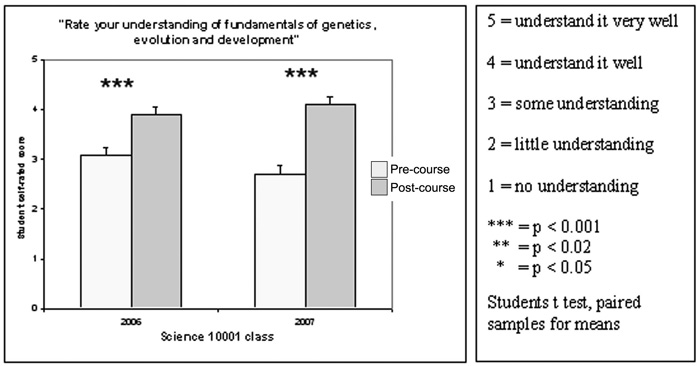
Figure 9b
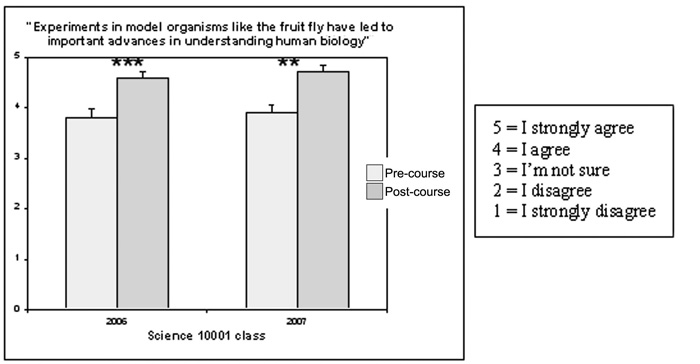
Figure 9c
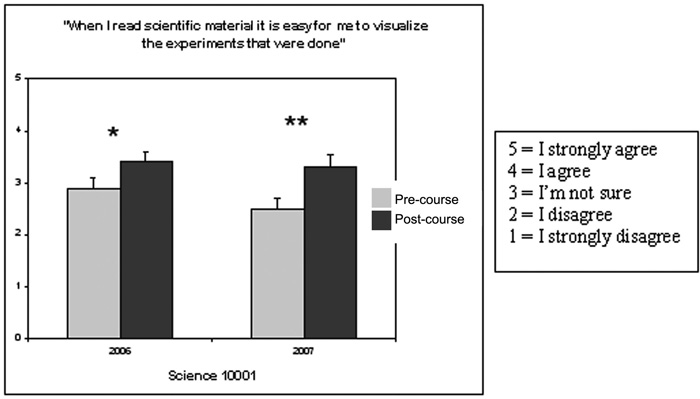
Figure 9d
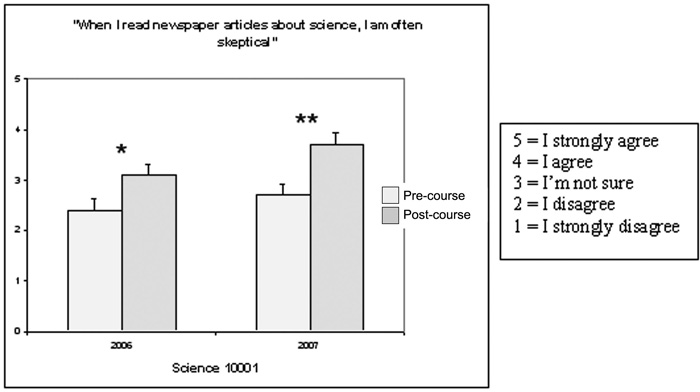
Students in “Man and Nature; Life” (Science 10001), a course for non-science majors in the City College of New York Honors College, took an anonymous survey pre- and post-course, responding on a five-point scale to statements about science or to the request to rate their understanding of science (Figure 9a). The surveys were coded using numbers known only to participants (see Hoskins, Stevens & Nehm, 2007). Average score pre and post; error bar = standard error. N = 16 (2006); N = 15 (2007).
Faculty tend to teach as they were taught, and most college science teachers are trained by lecturers. Unlike K–12 teachers, college faculty are largely untrained in theories of teaching and learning. This situation, coupled with the multiple demands on faculty time, can make it difficult for professors to shift their teaching style away from the lecture format (see Hoskins & Stevens, 2009). The active-learning classroom activities with which I have experimented are designed to facilitate change by decreasing preparation time and capitalizing on faculty members’ deep understanding of scientific process. Working scientists constantly evaluate data, design studies, and vet proposals. Faculty who bring these authentic (and high-Bloom scale; see Figure 1) activities into the classroom can thus play to their strengths, while also benefiting general education students by revealing who does science, what scientists do, and why they do it. Rather than delivering a detailed lecture, a teacher using approaches of the sort outlined above will coach students in developing scientific reasoning skills in a class session that resembles a lab meeting. Ideally, providing students a new toolkit of approaches for understanding biology and helping them use the tools to analyze and intelligently criticize data, to design models, and to outline novel experiments will help develop a cadre of science-aware citizens who appreciate science as a way of knowing, understand what drives scientists, and respect the goals of research science.1
ENDNOTES
REFERENCES
Alberts, B. 2005. A wakeup call for science faculty. Cell 123:739–741.
Allen, D., and K. Tanner. 2003. Approaches to cell biology teaching: Mapping the journey—Concept maps as signposts of developing knowledge structures. Cell Biology Education 2(3):133–136.
Alvarez-Buylla, A., M. Theelen, and F. Nottebohm. 1988. Birth of projection neurons in the higher vocal center of the canary forebrain before, during, and after song learning. Proceedings of the National Academy of Sciences of the United States of America 85:8722–8726.
American Association for the Advancement of Science (AAAS). 1989. Science for All Americans: A Project 2061 Report on Literacy Goals in Science, Mathematics, and Technology. Washington, D.C.: AAAS.
———. 1990. Science for All Americans. New York: Oxford University Press.
Berg, C. A., and D. G. Philips. 1994. An investigation of the relationship between logical thinking structures and the ability to construct and interpret line graphs. Journal of Research in Science Teaching 31:323–344.
Bloom, B., M. Englehart, E. Furst, W. Hill, and D. Krathwohl. 1956. A Taxonomy of Educational Objectives: Handbook 1: Cognitive Domain. New York: McKay.
Bransford, J., A. Brown, and R. R. Cocking. 2000. How People Learn: Brain, Mind, Experience, and School. Expanded Ed. Washington, D.C.: National Academies Press.
Brooks, J. G., and M. G. Brooks. 1993. The Case for Constructivist Classrooms. Alexandria, Va.: Association for Supervision and Curriculum Development.
Clement, J. 1989. The concept of variation and misconceptions in Cartesian graphing. Focus on Learning Problems in Mathematics 11:77–87.
Elliott, P. 2006. Reviewing newspaper articles as a technique for enhancing the scientific literacy of student-teachers. International Journal of Science Education 28(11):1245–1265.
Foertsch, J. 2000. Models for undergraduate instruction: The potential of modeling and visualization technology in science and math education. In Targeting Curricular Change: Reform in Undergraduate Education in Science, Math, Engineering, and Technology, 37–40. Washington, D.C.: American Association for Higher Education.
Glenn Commission. 2000. Before It’s Too Late: A Report to the Nation from The National Commission on Mathematics and Science Teaching for the 21st Century. Washington, D.C.: U.S. Department of Education.
Godsave, S. F., and J. M. Slack. 1989. Clonal analysis of mesoderm induction in Xenopus laevis. Developmental Biology 134:486–490.
Goldman, S. A., and F. Nottebohm. 1983. Neuronal production, migration, and differentiation in a vocal control nucleus of the adult female canary brain. Proceedings of the National Academy of Sciences of the United States of America 80(8):2390–2394.
Grunz, H., and H. Tacke. 1989. Neural differentiation of Xenopus laevis ectoderm takes place after disaggregation and delayed reaggregation without inducer. Cell Differentiation and Development 28:211–218.
Gudrais, E. 2007. Teen tune-out nixing the news. Harvard Magazine 110(2). http://harvardmagazine.com/2007/11/nixing-the-news.html.
Handlesman, J., D. Ebert-May, R. Beichner, P. Bruns, A. Chang, R. DeHaan, J. Gentile, S. Laufer, S. Tighlman, and W. Wood. 2004. Scientific teaching. Science 304:521–522.
Hemmati-Brivanlou, A., and D. Melton. 1992. A truncated activin receptor inhibits mesoderm induction and formation of axial structures in Xenopus embryos. Nature 359:609–614.
———. 1994. Inhibition of activin receptor signaling promotes neuralization in Xenopus. Cell 77:273–281.
———. 1997. Vertebrate embryonic cells will become nerve cells unless told otherwise. Cell 88:13–17.
Holtfreter, J. 1933. Die totale Exogastrulation, eine Selbstablösung des Ektoderms vom Endomesoderm. Wilhelm Roux’ Archiv für Entwicklungsmechanik der Organismen 129:669–793.
Hoskins, S. G. 2008. Using a paradigm shift to teach neurobiology and the nature of science: A C.R.E.A.T.E.-based approach. Journal of Undergraduate Neuroscience Education 6(2):A40–A52.
———. 2010. “But if it’s in the newspaper, doesn’t that mean it’s true?” Developing critical reading and analysis skills by analyzing newspaper science with C.R.E.A.T.E. American Biology Teacher 72(7):415–420.
———, and L. S. Stevens. 2009. Learning our L.I.M.I.T.S.: Less is more in teaching science. Advances in Physiology Education 33:17–20.
———, L. S. Stevens, and R. H. Nehm. 2007. Selective use of primary literature transforms the classroom into a virtual laboratory. Genetics 176:1381–1389.
Kaplan, M. S. 2001. Environmental complexity stimulates visual cortex neurogenesis: Death of a dogma and a research career. Trends in Neuroscience 24(10):617–620.
Kitchen, E., J. D. Bell, S. Reeve, R. Sudweeks, and W. Bradshaw. 2003. Teaching cell biology in the large-enrollment classroom: Methods to promote analytic thinking and assessment of their effectiveness. Cell Biology Education 2(3):180–194.
Knight, J. K., and W. B. Wood. 2005. Teaching more by lecturing less. Cell Biology Education 4(4):298–310.
Knight Foundation. 2007. Survey finds young Americans’ news use is half that of older adults: Teens’ daily news use is even lower than that of young adults. Press release, http://www.knightfoundation.org/news/press_room/knight_ press_releases/detail.dot?id=13032.
Kudoh, T., M. L. Concha, C. Hourat, I. B. Dawid, and S. W. Wilson. 2004. Combinatorial Fgf and Bmp signaling patterns the gastrula ectoderm into prospective neural and epidermal domains. Development 131:3581–3592.
Kuhn, T. S. 1970. The structure of scientific revolutions. 2nd Ed. Chicago: University of Chicago Press.
Lall, S., and N. H. Patel. 2001. Conservation and divergence in molecular mechanisms of axis formation. Annual Review of Genetics 35:407–437.
Mathewson, J. H. 1999. Visual-spatial thinking: An aspect of science overlooked by educators. Science Education 83:33–35.
Mayell, H. 2005. Babies recognize faces better than adults, study says. National Geographic News, May 22. http://news.nationalgeographic.com/news/2005/ 03/0321_050321_babies.html.
Mead, J., and L. Scharmann. 1994. Enhancing critical thinking through structured academic controversy. American Biology Teacher 56:416–419.
Muench, S. 2000. Choosing primary literature in biology to achieve specific educational goals. Journal of College Science Teaching 29:255–260.
National Research Council. 1996. National Science Education Standards. Washington, D.C.: National Academies Press.
———. 2000. Inquiry and the National Science Education Standards: A Guide for Teaching and Learning. Washington, D.C.: National Academies Press.
———. 2003a. Bio 2010: Transforming Undergraduate Education for Future Research Biologists. Washington, D.C.: National Academies Press.
———. 2003b. Evaluating and Improving Undergraduate Teaching in Science, Technology, Engineering and Mathematics. Washington, D.C.: National Academies Press.
Nieuwkoop, P. D. 1969. The formation of mesoderm in urodelan amphibians. Paper I. Induction by the endoderm. Roux’s Archives of Developmental Biology 162:341–373.
Novak, J. D. 1990. Concept mapping: A useful tool for science education. Journal of Research in Science Teaching 27:937–949.
———. 1998. Learning, Creating and Using Knowledge: Concept Maps TM as Facilitative Tools in Schools and Corporations. Mahwah, N.J.: Lawrence Erlbaum Association.
———, and G. B. Gowin. 1984. Concept mapping for meaningful learning. In Learning How to Learn, 15–54. New York: Cambridge University Press.
Oulton, C., and M. M. Grace. 2004. Reconceptualizing the teaching of controversial issues. International Journal of Science Education 26:411–423.
Pascalis, O., L. Scott, D. Kelly, R. Shannon, E. Nicholson, W. Coleman, and C. Nelson. 2005. Plasticity of face processing in infancy. Proceedings of the National Academy of Sciences of the United States of America 102:5297–5300.
Paton, J. A., and F. N. Nottebohm. 1984. Neurons generated in the adult brain are recruited into functional circuits. Science 225:1046–1048.
———, B. E. O’Loughlin, and F. Nottebohm. 1985. Cells born in adult canary forebrain are local interneurons. Journal of Neuroscience 5(11):3088–3093.
Rundle, R. 2005. Study links produce prices to obesity. The Wall Street Journal, October 6.
Ryder, J., J. Leach, and R. Driver. 1999. Undergraduate students’ images of science. Journal of Research in Science Teaching 36(2):201–209.
Salie, R., V. Nierderofler, and S. Arber. 2005. Patterning molecules: Multitasking in the nervous system. Neuron 45:189–192.
Schnotz, W., E. Picard, and A. Hron. 1993. How do successful and unsuccessful learners use texts and graphics? Learning and Instruction 3:181–199.
Seethaler, S. 2005. Helping students make links through science controversy. American Biology Teacher 67:265–274.
Siebert, E. D., and W. J. McIntosh. 2001. College Pathways to the Science Education Standards. Arlington, Va.: National Science Teachers Association.
Spemann, H., and H. Mangold. 1924. Über induktion von Embryonalagen durch Implantation Artfremder Organisatoren. Wilhelm Roux’ Archiv für Entwicklungsmechanik der Organismen 100:599–638.
Steitz, J. 2003. Commentary: Bio 2010—New challenges for science educators. Cell Biology Education 2(2):87–91.
Strauss, B. 2005. Pub Med, The New York Times, and The Chicago Tribune as tools for teaching genetics. Genetics 171:1449–1454.
Sturm, R., and A. Datar. 2005. Body mass index in elementary school children, metropolitan area food prices and food outlet density. Public Health 119(12): 1059–1068.
Zimmerman, L., J. De Jesus-Escobar, and R. Harland. 1996. The Spemann organizer signal noggin binds and inactivates bone morphogenetic protein 4. Cell 86:599–606.